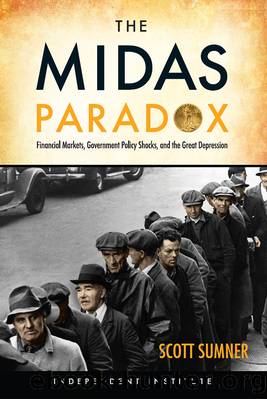The Midas Paradox by Scott B Sumner

Author:Scott B Sumner
Language: eng
Format: epub
Tags: -
Publisher: Independent Publishers Group
Published: 2015-10-19T00:00:00+00:00
In the preceding three chapters we have seen evidence of rapid inflation in an extremely depressed economy, rapid change in real wages (even before implementation of the NIRA), and industrial production responding almost immediately to monetary shocks.
Obviously, I have not formally tested any of the preceding three stylized facts, but at least the first of these âfactsâ would be exceedingly difficult to reconcile with the observed changes in the U.S. price level after the dollar was devalued. Rather, the stylized facts of 1933 actually seem more consistent with the more âold-fashionedâ interpretation of the Phillips curveâthe Irving Fisher/Milton Friedman view that the causation ran from (unanticipated) changes in inflation to changes in output. Again, this is just one episode, but given how difficult it is to identify truly exogenous monetary shocks, it is disturbing that the most powerful and clearly identifiable monetary shock seemed to produce effects that donât conform very closely to those predicted by the standard new Keynesian model.
At least the new Keynesian model allows for monetary shocks to have real effects. There are numerous alternative approaches, ranging from old (or post-) Keynesian to new classical, which have raised doubts about the efficacy of monetary policy during a severe depression. Some have suggested that moneyoutput correlations may be highly misleading because of the possible endogeneity of monetary policy. One of the reasons I provided such a detailed account of the political factors associated with dollar depreciation is to show that many of the major changes in the value of the dollar were associated with actions or statements made by the Roosevelt administration. In many respects, a better case can be made for monetary policy exogeneity during April 1933 through February 1934, than during the postwar data so favored by modern macroeconomists.46 Monetary policy doesnât get much more exogenous than this:
One morning (it was Friday, November 3), when Morgenthau came to the bedside tense with worry over some pressing problem and suggested that the [gold] price change that day be considerably greater than the 10 to 15 cents of immediately preceding days, Roosevelt promptly announced that the increase would be 21 cents. Why that figure? Because âthree times sevenâ is a lucky number, said Roosevelt, his face straight but his blue eyes twinkling at Morgenthauâs recoil from such frivolous dealing with a serious matter (quoted in Davis, 1986, p. 294)
The policy experiments of 1933 also had an important impact on policy developments during the mid to late 1930s. One reason the gold bloc currencies were under so much pressure during the fall of 1933 was the perception that a successful U.S. devaluation would force other nations to follow. As the recovery faltered in late 1933, pressures on the gold bloc currencies eased.
Temin (1989, p. 124) noted that the after the popular front took office in 1936, its policies were âalmost the same as the labor measures introduced in America under the NRA. But they were introduced in a very different context, before rather than after devaluation.â Temin argued that
Download
This site does not store any files on its server. We only index and link to content provided by other sites. Please contact the content providers to delete copyright contents if any and email us, we'll remove relevant links or contents immediately.
International Integration of the Brazilian Economy by Elias C. Grivoyannis(91494)
The Radium Girls by Kate Moore(11927)
Turbulence by E. J. Noyes(7940)
Nudge - Improving Decisions about Health, Wealth, and Happiness by Thaler Sunstein(7622)
The Black Swan by Nassim Nicholas Taleb(7016)
Rich Dad Poor Dad by Robert T. Kiyosaki(6413)
Pioneering Portfolio Management by David F. Swensen(6229)
Man-made Catastrophes and Risk Information Concealment by Dmitry Chernov & Didier Sornette(5924)
Zero to One by Peter Thiel(5690)
Secrecy World by Jake Bernstein(4651)
Millionaire: The Philanderer, Gambler, and Duelist Who Invented Modern Finance by Janet Gleeson(4382)
The Age of Surveillance Capitalism by Shoshana Zuboff(4214)
Skin in the Game by Nassim Nicholas Taleb(4165)
Bullshit Jobs by David Graeber(4100)
The Money Culture by Michael Lewis(4082)
Skin in the Game: Hidden Asymmetries in Daily Life by Nassim Nicholas Taleb(3935)
The Dhandho Investor by Mohnish Pabrai(3704)
The Wisdom of Finance by Mihir Desai(3658)
Blockchain Basics by Daniel Drescher(3511)
